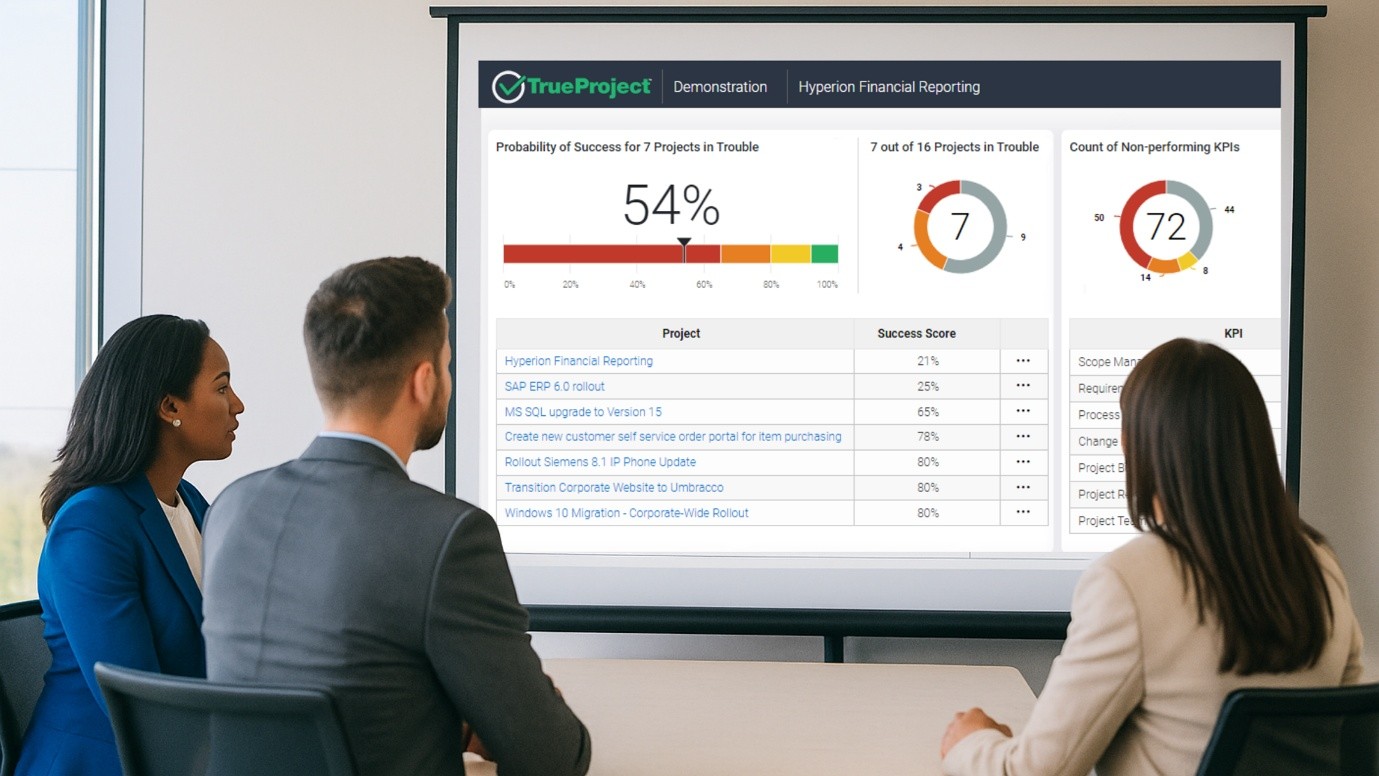
Quick Summary: Project leaders in 2025 face tighter margins for error, but the project status report—when powered by predictive intelligence—is emerging as the single most decisive tool for clarity, alignment, and foresight. This article lays out how strategic reporting design, intelligent data use, and continuous optimization are reshaping project outcomes across industries.
In an era of escalating project complexity, the project status report stands as a strategic solution, transforming intricate dynamics into clear, actionable insights. Far beyond routine updates, it empowers leaders to navigate risks, align stakeholders, and propel projects toward transformative outcomes. With 31% (saaslist.com, 2025) of companies citing miscommunication about project objectives as the top reason for failure, the project status report is a critical instrument for clarity and control. This article unveils how to craft and leverage project status reports to turn challenges into opportunities, delivering a roadmap for excellence in 2025.
As projects increasingly rely on collaborative efforts—90% require team collaboration over individual contributions—effective reporting is a competitive edge (saaslist.com, 2025). Predictive intelligence enhances this edge, enabling proactive decision-making that anticipates risks and optimizes resources. From strategic oversight to continuous improvement, a well-executed project status report mitigates risks, fosters trust, and drives measurable results. This exploration begins by examining its strategic importance, optimal design, and data-driven potential.

Elevating Strategic Oversight with the Project Status Report
The project status report is the cornerstone of strategic project management, offering a clear lens into progress, risks, and opportunities. With 80% of employees spending half their workweek on rework due to misaligned objectives, these reports bridge the gap between execution and strategy (saaslist.com, 2025). By leveraging predictive intelligence to anticipate challenges, the project status report enables leaders to steer initiatives with precision, ensuring alignment and driving success across complex portfolios.
Why the Project Status Report Is Essential
A project status report transcends mere documentation, serving as a strategic tool that aligns teams and stakeholders through predictive insights. Its core benefits include:
- Unmatched Visibility - Illuminates milestones and progress, ensuring a shared understanding of project trajectory and potential hurdles.
- Proactive Risk Management - Flags issues early, addressing the 12% of project failures caused by unclear task dependencies.
- Stakeholder Confidence - Delivers transparent, forward-looking updates, fostering trust and alignment across diverse teams.
Projects with high management maturity, including robust reporting, are 2.5 times more likely to succeed. For example, the 2023 renovation of London’s Battersea Power Station relied on predictive reporting to align global stakeholders, avoiding delays. By prioritizing strategic oversight, the project status report transforms data into a narrative of progress, setting the foundation for impactful communication.
Looking to lead projects with precision? Start using project status reports that forecast risks—not just reflect them.
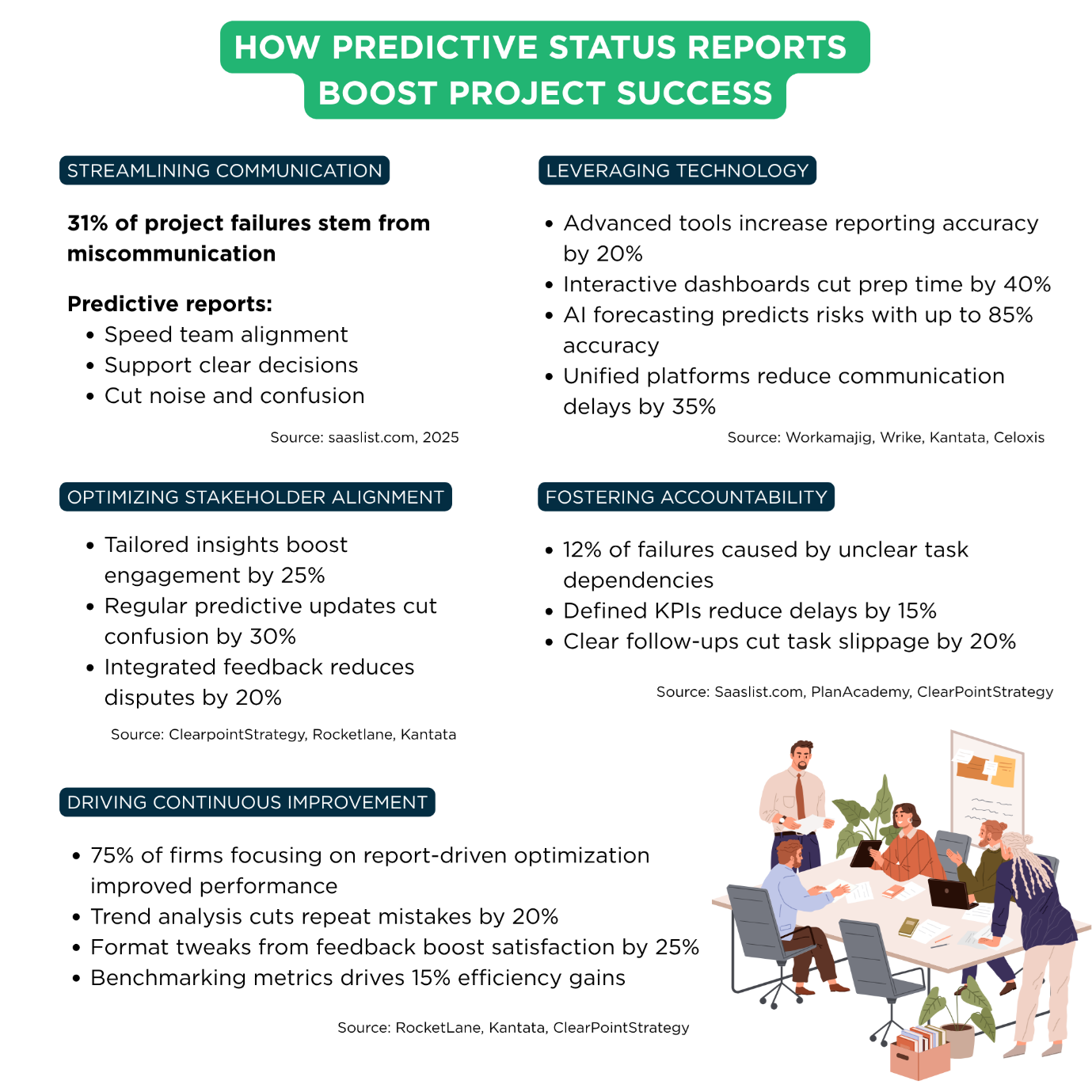
Designing Clarity in the Project Status Report
Building on the visibility provided by a project status report, its design determines its ability to communicate effectively. Poorly structured reports risk overwhelming stakeholders or burying critical insights, while well-crafted ones distill complexity into clarity. By anticipating stakeholder needs, the project status report becomes a powerful tool for strategic alignment.
Crafting an Impactful Project Status Report
An effective project status report balances brevity with depth, using predictive insights to tailor content to stakeholder priorities. Key design elements include:
- Executive Summary - A concise overview of project health, achievements, and concerns, highlighting predictive trends for proactive planning.
- Visual Clarity - Charts or dashboards enhance engagement by 25% through intuitive data presentation, simplifying complex metrics.
- Action-Oriented Recommendations - Clear, predictive next steps ensure decisions are practical and forward-looking.
A well-designed project status report not only informs but also inspires confidence, aligning stakeholders on shared goals.
Harnessing Data for Strategic Project Status Reports
The clarity of a well-designed project status report sets the stage for its evolution into a data-driven powerhouse. By integrating predictive metrics, reports become proactive tools for anticipating challenges and optimizing outcomes. In 2024, firms using real-time project tracking tools saw a 20% reduction in schedule deviations (workamajig.com). Predictive intelligence elevates this capability, enabling leaders to foresee risks and align resources with precision.
Key Metrics for a Data-Driven Project Status Report
To maximize strategic impact, a project status report should prioritize metrics aligned with project goals, enhanced by predictive analytics. Essential data points include:
- Schedule Adherence - Tracks progress against timelines, addressing the 46% of team leaders who cite meeting deadlines as their top challenge.
- Budget Performance - Monitors cost variance, with Earned Value Management improving accuracy by 15%.
- Risk Indicators - Uses predictive analytics to forecast issues with up to 85% accuracy, enabling proactive mitigation.
The project status report becomes a strategic compass by embedding these metrics, guiding projects with foresight and precision.

Designing Clarity in the Project Status Report
Building on the strategic visibility provided by a well-structured project status report, its design directly influences how effectively information is absorbed and acted upon. Poorly organized reports can obscure crucial data or overwhelm stakeholders, while a well-structured one streamlines complexity into clarity. With 55% of team members citing unclear project objectives as a major hurdle, designing a predictive, structured status report becomes essential for alignment and progress [saaslist.com, 2025].
Crafting an Impactful Project Status Report
A high-performing project status report balances brevity with depth, using predictive intelligence to tailor content to stakeholder priorities. Key design components include:
- Executive Summary - A brief snapshot of project health, recent achievements, and emerging concerns—enriched by predictive trends for timely foresight.
- Visual Clarity - Dashboards and charts enhance engagement by 25% [clearpointstrategy.com], offering intuitive navigation through complex metrics.
- Action-Oriented Recommendations - Concrete, predictive next steps ensure stakeholders stay aligned and decisions remain forward-looking.
By designing project status reports that prioritize clarity, leaders foster trust and align teams on shared objectives.
Harnessing Data for Strategic Project Status Reports
A well-designed project status report lays the foundation for transforming raw data into strategic foresight. With 2024 stats showing firms using real-time tracking tools cut schedule deviations by 20%, data has moved from passive reflection to active decision support [workamajig.com, 2024]. Predictive intelligence sharpens this edge, equipping leaders to foresee issues and act with precision.
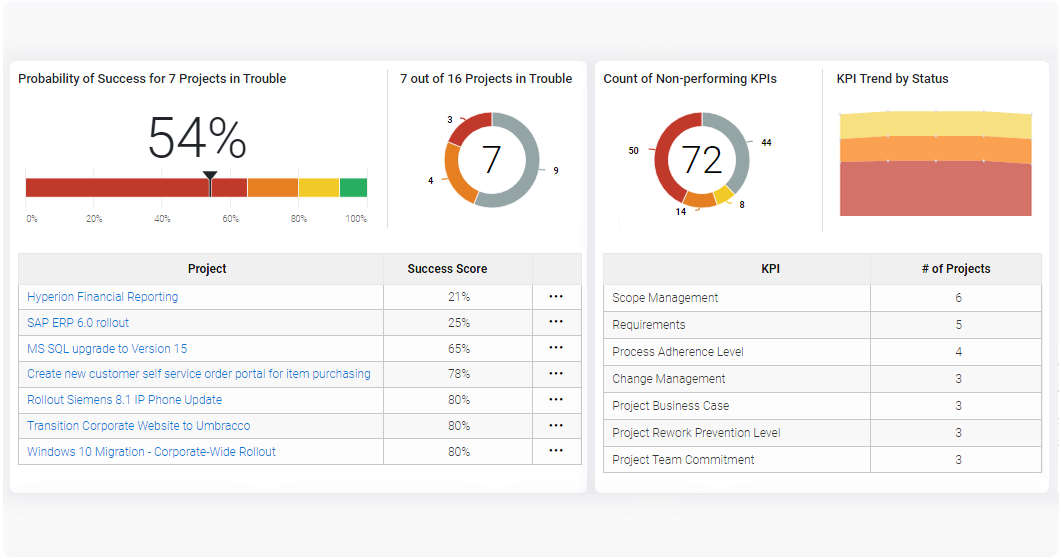
Key Metrics for a Data-Driven Project Status Report
To ensure strategic impact, status reports should anchor on metrics enhanced by predictive analytics:
- Schedule Adherence - Tracks progress against planned timelines, directly addressing the 46% of project managers who cite deadline pressure as their top challenge.
- Budget Performance - Monitors financial health using Earned Value Management (EVM), with predictive analytics improving accuracy.
- Risk Indicators - Forecasts vulnerabilities with up to 85% accuracy, giving project teams a proactive stance.
Don’t just report—lead with insight. Add predictive technology to your project status reports for faster, clearer outcomes. Experience the TrueProject Difference with Quick-Start Plan.
Streamlining Communication Through the Project Status Report
Data alone doesn’t drive results—communication does. With 31% of project failures rooted in miscommunication, a well-crafted status report serves as the keystone of transparent collaboration [saaslist.com, 2025]. When enhanced by predictive intelligence, it enables teams to align faster, make clearer decisions, and reduce the noise that slows progress.
Optimizing Stakeholder Alignment with the Project Status Report
A project status report infused with predictive intelligence transforms communication from reactive to strategic. Key approaches include:
- Tailored Insights - Delivering the right level of detail to the right audience—executives receive strategic forecasts while teams receive operational updates.
- Consistent Cadence - Scheduled reports aligned with predictive trends reduce unnecessary check-ins and clarify next steps, minimizing stakeholder confusion.
- Feedback Integration - Mechanisms for input allow reports to evolve, cutting disputes and improving overall cohesion.
With tailored, intelligent reporting, status reports evolve into the organization’s communication backbone, ensuring smoother updates and minimized misalignment.
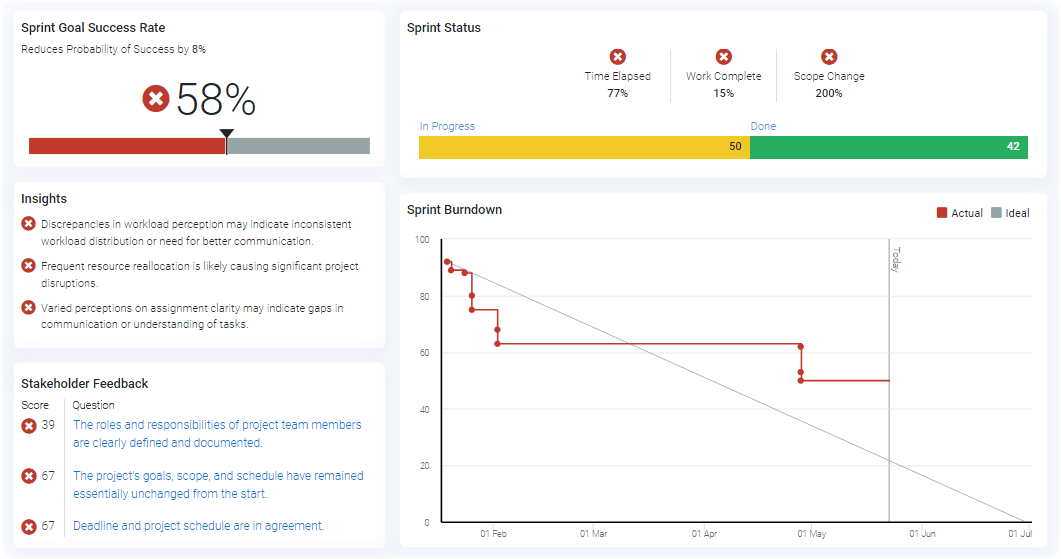
Communication can make or break a project. Use predictive reporting to bring clarity and unity—before uncertainty takes hold. Watch Short Demo.
Leveraging Technology for Enhanced Project Status Reports
As communication strengthens stakeholder alignment, technology enhances the project status report into a predictive powerhouse. In 2024, teams using advanced reporting tools improved accuracy by 20%, driven by real-time analytics and AI. These advancements enable reports to evolve from static summaries into dynamic, forward-looking tools.
Technology-Driven Strategies for the Project Status Report
To fully harness predictive capabilities, modern project status reports should embrace technologies that deliver strategic foresight:
- Interactive Dashboards - Platforms reduce preparation time by 40% by offering real-time, interactive data visualization.
- AI-Powered Forecasting - AI solutions identify project risks with up to 85% accuracy, allowing early interventions.
- Cloud-Based Integration - Unified platforms ensure seamless data flow, cutting communication delays by 35%.
Through intelligent technology integration, the project status report becomes a command center for real-time strategy.
Fostering Accountability with the Project Status Report
Precision enabled by technology naturally sharpens accountability. When a project status report clearly defines roles, KPIs, and forecasted outcomes, it sets the stage for ownership and follow-through. With 12% of failures tied to unclear task dependencies, a predictive, accountable report is vital [saaslist.com, 2025].
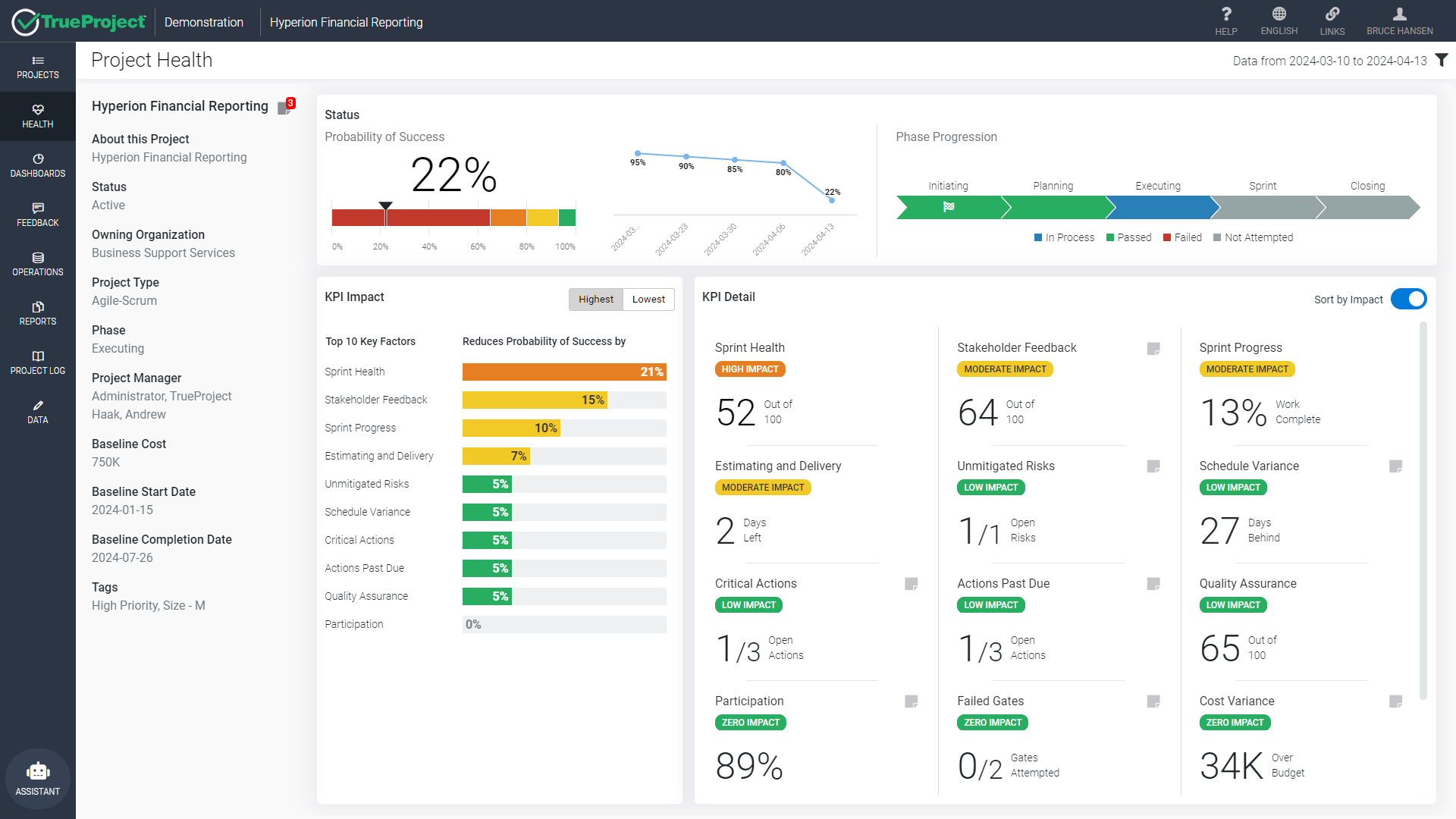
Embedding Accountability in the Project Status Report
Predictive intelligence software empowers reports to instil responsibility while anticipating breakdowns. Best practices include:
- Defined Metrics and Roles - Assign measurable KPIs (e.g., task completion rates) to individuals, reducing delays.
- Proactive Tracking - Predictive milestones highlight gaps before they widen, ensuring timely action and transparency.
- Actionable Follow-Ups - Embed clear next steps with deadlines, cutting task slippage.
In infrastructure projects managed through predictive dashboards ensured roles were tracked and performance was measurable—raising success rates and stakeholder confidence.
Avoid costly missteps. Use predictive project status reports to align everyone before confusion derails your outcomes. Book a Demo now!
Driving Continuous Improvement Through the Project Status Report
With accountability embedded, the project status report becomes a mechanism for continuous learning. In 2024, 75% of firms focusing on process optimization through reporting saw enhanced performance [planacademy.com, 2024]. Predictive intelligence not only prevents issues but also fuels iterative refinement.
Advancing Excellence with the Project Status Report
Continuous improvement stems from leveraging predictive feedback loops and learning from each phase. Key strategies include:
- Lessons Learned Analysis - Use trend data to identify recurring issues, reducing repeat errors.
- Dynamic Refinement - Adjust reporting format based on predictive feedback, improving stakeholder satisfaction.
- Performance Benchmarking - Compare key metrics against historical and industry standards, leading to gains in efficiency.
Predictive status reports transform feedback into fuel for sustained excellence.
What gets measured gets improved—especially when your report can predict the road ahead. Let your status report be the engine of continuous progress.
Conclusion: Redefining Project Success with the Project Status Report
Project status reports are becoming the most reliable way to drive clarity, accountability, and alignment—especially when supported by predictive intelligence. In a world where delays, cost overruns, and stakeholder misalignment can break outcomes, data-backed reporting becomes the anchor for confident decisions.
The true advantage lies in real-time visibility—not just into what’s happening, but what’s likely to happen next. Predictive metrics turn every report into a timely, actionable signal, enabling teams to adjust early and lead with foresight. From clearer communication to reduced rework, the strategic value of a modern project status report is tangible.
TrueProject, a KPI-based predictive project management SaaS solution, disrupts traditional reporting by combining AI-driven analytics, stakeholder feedback, and best-practice compliance to deliver actionable insights. Its ability to identify issues early, reduce rework and provide real-time dashboards empowers leaders to optimize outcomes with unmatched precision. As a scalable platform with seamless integrations and rapid deployment, TrueProject transforms project oversight, ensuring strategic alignment and measurable success. Discover TrueProject.
Stop settling for static updates. Upgrade your project status reports with TrueProject’s predictive foresight to lead with clarity and control. Schedule a Discussion Today!
FAQs
- What is a predictive project status report?
A predictive project status report uses real-time data to forecast risks and keep projects on schedule. - How do project status reports improve communication?
They provide clear, regular updates that reduce miscommunication and align teams. - Why are predictive metrics important in project reporting?
They highlight risks early, helping projects stay on time and within budget.






